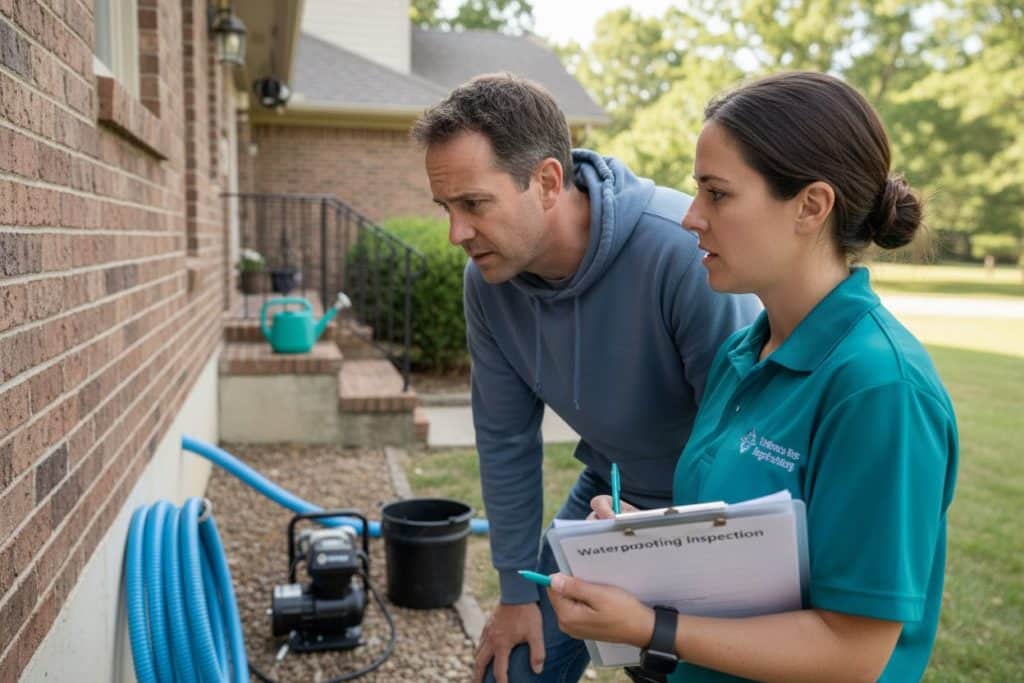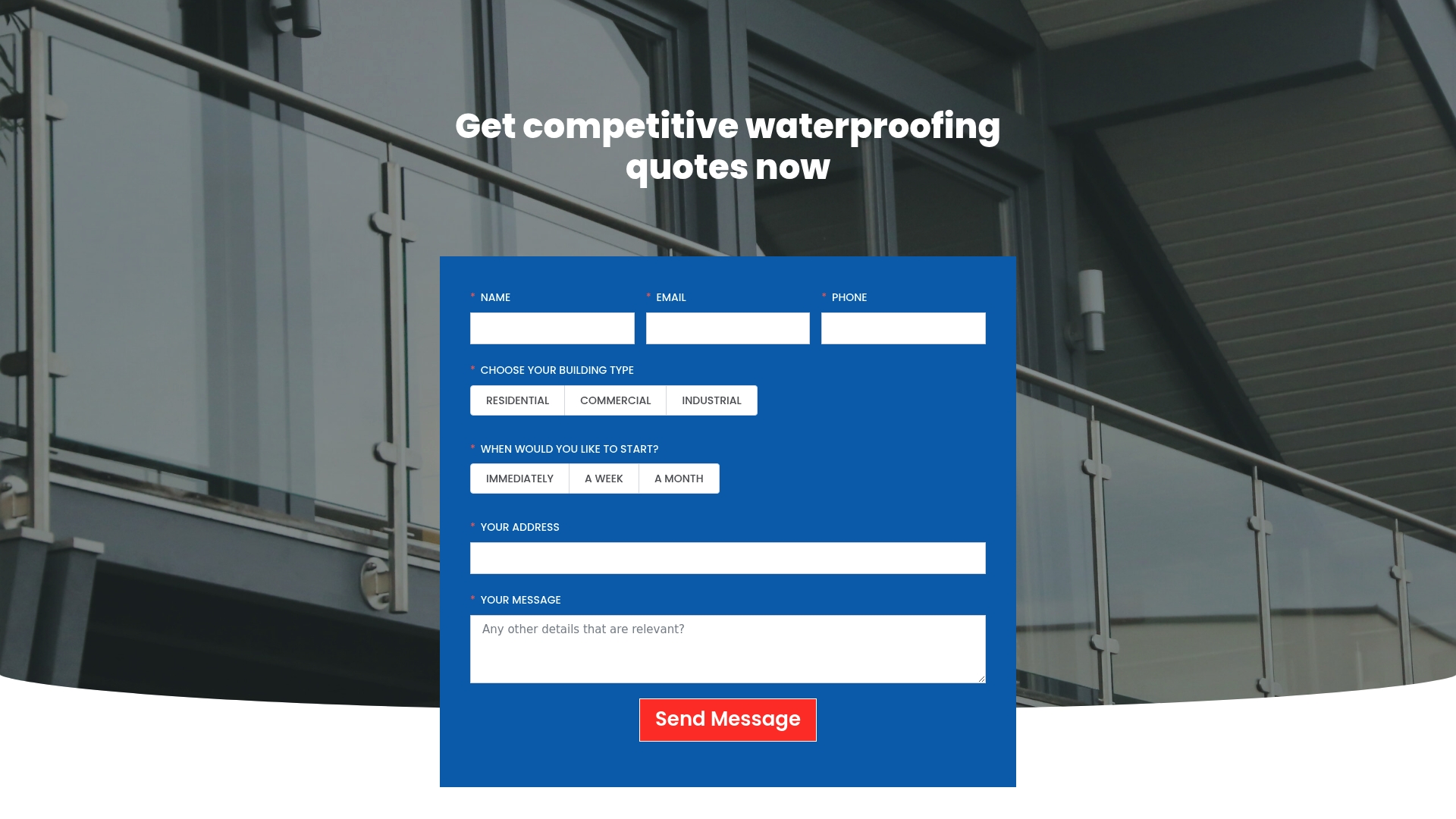Waterproofing inspections might sound straightforward and routine yet they play a far bigger role in property care than most people realise. Up to 80 percent of water damage cases could have been prevented by a proper waterproofing inspection, according to recent studies. People often think only old or visibly damp buildings are at risk but hidden vulnerabilities can exist anywhere. Sometimes the most pristine-looking homes are the ones masking silent water threats waiting to cause chaos.
Table of Contents
- What Is Waterproofing Inspection And Its Importance?
- Why Waterproofing Matters For Property Longevity
- Key Concepts Of Waterproofing Systems And Inspections
- How Waterproofing Inspection Works And Its Process
- Common Issues And Solutions Identified During Inspections
Quick Summary
| Takeaway | Explanation |
|---|---|
| Early inspections prevent costly repairs | Identifying vulnerabilities early allows for timely interventions, saving money on extensive repairs later on. |
| Target key structural areas during inspections | Focus on foundations, drainage systems, and roofing to detect potential moisture pathways effectively. |
| Waterproofing enhances property value | Effective moisture management preserves structural integrity and maintains property market value. |
| Use advanced technology in assessments | Employ tools like thermal imaging and moisture meters for precise detection of water intrusion risks. |
| Proactive measures mitigate health risks | Addressing water damage early can prevent mould growth and associated health hazards. |
What is Waterproofing Inspection and Its Importance?
Waterproofing inspection represents a critical assessment process designed to evaluate a property’s vulnerability to water intrusion and potential structural damage. Comprehensive water damage prevention starts with understanding how moisture can compromise building integrity and identifying potential risk zones before significant problems emerge.
Understanding the Fundamental Purpose
A waterproofing inspection involves a systematic evaluation of a property’s structural elements, focusing on identifying existing or potential water penetration pathways. Professional inspectors meticulously examine foundation walls, basement areas, roof structures, exterior surfaces, and internal moisture barrier systems to detect signs of water vulnerability.
To clarify the primary focus areas addressed during a waterproofing inspection, the table below outlines the structural elements typically evaluated and the specific vulnerabilities assessed for each.
| Structural Element | Vulnerabilities Assessed |
|---|---|
| Foundation walls | Cracking, seepage, and damp ingress |
| Basement areas | Moisture pooling, wall staining, and floor damp |
| Roof structures | Membrane breakdown, water entry points, and leakage risk |
| Exterior surfaces | Weather exposure, sealant failure, and protective coating wear |
| Internal moisture barriers | Barrier breaches, insulation degradation, and hidden damp |
Key areas of focus during these inspections include:
- Structural foundation integrity
- Exterior wall and roof membrane conditions
- Drainage system effectiveness
- Potential moisture accumulation zones
- Signs of existing water damage or degradation
Why Waterproofing Inspections Matter
Waterproofing inspections serve as a proactive maintenance strategy that protects property investments from potentially catastrophic water damage.

By identifying vulnerabilities early, property owners can implement targeted interventions that address potential water intrusion points before they escalate into significant structural problems. Learn more about our comprehensive waterproofing services to understand how professional inspections can safeguard your property investment.
The financial implications of neglecting water damage prevention can be substantial. Water-related structural damage can compromise building foundations, create unsafe living environments, and result in exponentially higher repair costs compared to preventative maintenance.
Why Waterproofing Matters for Property Longevity
Waterproofing plays a pivotal role in preserving structural integrity and extending property lifespan through strategic moisture management. Moisture control research indicates that proactive water protection measures can significantly reduce structural degradation and prevent expensive long-term maintenance challenges.
Structural Integrity and Material Preservation
Building materials are inherently vulnerable to water damage, which can trigger progressive deterioration processes. Continuous moisture exposure compromises concrete, wood, steel, and other construction materials, leading to corrosion, decay, and potential structural failure. Water infiltration weakens foundational elements, causing microscopic cracks that expand over time and compromise overall building stability.
Key material vulnerability points include:
- Foundation concrete degradation
- Timber frame structural weakening
- Metal reinforcement corrosion
- Insulation performance reduction
- Masonry structural integrity compromise
Economic and Long-Term Property Value Protection
Effective waterproofing represents a strategic investment that directly impacts property valuation and maintenance expenditure. Learn more about waterproofing as a non-negotiable property protection strategy, which helps property owners understand the financial implications of moisture management.
Property owners who implement comprehensive waterproofing strategies can anticipate substantial long-term benefits. Water damage prevention minimises repair costs, maintains structural resilience, and preserves property market value. Unaddressed water intrusion can lead to exponential damage, potentially reducing property value and creating significant financial burdens through extensive rehabilitation requirements.
Key Concepts of Waterproofing Systems and Inspections
Waterproofing systems represent sophisticated protective technologies designed to prevent moisture penetration and safeguard structural integrity. Advanced building envelope protection techniques demonstrate the complex engineering behind effective water management strategies for residential and commercial properties.
Core Components of Waterproofing Systems
Waterproofing involves multiple interconnected layers and techniques that work synergistically to repel and redirect moisture. Professional waterproofing solutions integrate various materials and methods to create comprehensive barriers against water intrusion. These systems typically encompass external and internal protection mechanisms that address different potential moisture entry points.
Critical waterproofing system components include:
- Protective membrane installations
- Drainage infrastructure
- Sealant applications
- Hydrophobic coating technologies
- Structural waterproofing treatments
Technical Classifications and Inspection Methodologies
Waterproofing inspections require sophisticated diagnostic approaches to evaluate system effectiveness. Professionals utilise advanced technological tools and empirical assessment techniques to identify potential vulnerabilities. Explore our comprehensive waterproofing guide to understand the intricate process of moisture management and protection strategies.
Inspection methodologies focus on detecting subtle indicators of potential water infiltration, including microscopic surface changes, material degradation patterns, and structural stress points. Trained specialists employ specialised equipment such as moisture meters, thermal imaging cameras, and structural scanning technologies to perform precise evaluations of waterproofing system performance.
How Waterproofing Inspection Works and Its Process
Waterproofing inspections represent a systematic approach to identifying and mitigating potential moisture vulnerabilities within property structures. Advanced diagnostic protocols demonstrate the precision and complexity involved in comprehensive moisture management assessments.
Professional Assessment and Initial Evaluation
Comprehensive waterproofing inspections begin with a holistic property assessment that combines visual examination, technological diagnostics, and detailed structural analysis. Professional inspectors conduct thorough investigations using specialised equipment to detect hidden moisture penetration risks and potential structural weaknesses.
Critical initial evaluation components include:
- Comprehensive exterior structural scanning
- Detailed foundation perimeter assessment
- Interior wall and ceiling moisture mapping
- Drainage system functionality review
- Historical moisture damage documentation
Technical Diagnostic Procedures
Inspectors utilise advanced technological tools to perform precise moisture detection and structural integrity assessments. Thermal imaging cameras, moisture meters, and non-invasive scanning technologies enable professionals to identify subtle water infiltration indicators without causing additional property damage.
Explore our professional waterproofing inspection techniques to understand the sophisticated approach employed by expert technicians. These diagnostic procedures provide property owners with comprehensive insights into potential water intrusion risks, enabling proactive maintenance and strategic protective interventions.
The inspection process involves methodical data collection, comparative analysis, and professional recommendations tailored to each property’s unique structural characteristics and environmental challenges.
Common Issues and Solutions Identified During Inspections
Waterproofing inspections reveal a spectrum of moisture-related challenges that can significantly impact property structural integrity and long-term performance. Building envelope vulnerability assessment provides comprehensive insights into the complex interactions between structural elements and environmental moisture conditions.
Structural Moisture Vulnerability Patterns
Water infiltration vulnerabilities manifest through multiple complex pathways, each presenting unique diagnostic challenges for professional inspectors. Structural moisture issues often emerge from interconnected environmental and architectural factors that require sophisticated diagnostic approaches.
To help property owners understand the most common issues detected during inspections and suitable remediation strategies, this table summarises the main vulnerability patterns and corresponding targeted solutions.
| Issue Identified | Description | Typical Remediation Strategy |
|---|---|---|
| Foundation perimeter seepage | Water ingress at foundation boundaries | Install/repair external drainage, membrane fixes |
| Roof membrane degradation | Deterioration of waterproof roof layers | Replace/restore membrane, seal roof joints |
| Subterranean water table interaction | Water entry due to high underground moisture | Introduce sump pumps, waterproof tanking |
| Structural joint compromise | Gaps or weaknesses at material intersections | Apply sealants, reinforce joints structurally |
| Inadequate drainage performance | Poor runoff management around the property | Upgrade gutters, redirect surface water |
Predominant moisture vulnerability categories include:
- Foundation perimeter seepage
- Roof membrane degradation
- Subterranean water table interactions
- Structural joint compromises
- Inadequate drainage system performance
Targeted Remediation Strategies
Successful waterproofing interventions demand precise, scientifically informed solutions tailored to specific structural vulnerabilities. Professional inspectors develop comprehensive remediation strategies that address root causes rather than merely treating surface symptoms.
Discover our expert waterproofing solution methodologies to understand the nuanced approach required for effective moisture management. Effective remediation encompasses advanced technological interventions, strategic material applications, and holistic structural rehabilitation techniques designed to prevent future moisture intrusion risks.
Protect Your Investment with a Professional Property Waterproofing Inspection
Have you started noticing tell-tale signs of moisture or are you unsure if your property is at risk of water intrusion? The article highlighted how unchecked water damage can threaten your home’s foundation and create costly repairs. If you are concerned about potential weak spots or the long-term integrity of your building, a thorough waterproofing inspection is your first line of defence.
Do not wait until small leaks turn into structural failures. Take control today by connecting with our experienced team at Pro Waterproofing. Learn more about tailored education and industry guidance for property owners in our Uncategorized Articles. Discover the proven solutions that set us apart and secure your free inspection quote now. Make the smart choice to protect your property and your peace of mind.
Frequently Asked Questions
What is a waterproofing inspection?
A waterproofing inspection is a comprehensive assessment of a property’s structural aspects to evaluate its vulnerability to water intrusion and assess potential risks that could lead to structural damage.
Why are waterproofing inspections important for property owners?
Waterproofing inspections are crucial as they help identify water penetration vulnerabilities early, allowing property owners to implement preventive measures, thereby avoiding costly structural repairs and health risks associated with mould growth.
What areas are examined during a waterproofing inspection?
Inspectors typically examine critical areas such as foundation walls, basement areas, roof structures, exterior surfaces, and internal moisture barrier systems to identify potential water vulnerabilities and existing damage.
How does the waterproofing inspection process work?
The waterproofing inspection process involves a systematic evaluation combining visual inspections with advanced diagnostic tools to identify moisture infiltration risks, assess structural integrity, and provide tailored recommendations for remediation.



